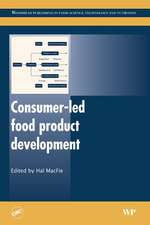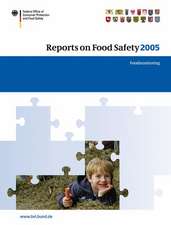Nanoparticle- and Microparticle-based Delivery Systems: Encapsulation, Protection and Release of Active Compounds
Autor David Julian McClementsen Limba Engleză Paperback – 19 ian 2017
Written by an international authority known for his clear and rigorous technical writing style, this book discusses the numerous kinds of active ingredients available and the issues associated with their encapsulation, protection, and delivery. The author takes a traditional colloid science approach and emphasizes the practical aspects of formulation of particulate- and emulsion-based delivery systems with food applications. He then covers the physicochemical and mechanical methods available for manufacturing colloidal particles, highlighting the importance of designing particles for specific applications.
The book includes chapters devoted specifically to the three major types of colloidal delivery systems available for encapsulating active ingredients in the food industry: surfactant-based, emulsion-based, and biopolymer-based. It then reviews the analytical tools available for characterizing the properties of colloidal delivery systems, presents the mathematical models for describing their properties, and highlights the factors to consider when selecting an appropriate delivery system for a particular application backed up by specific case studies.
Based on insight from the author’s own experience, the book describes why delivery systems are needed, the important factors to consider when designing them, methods of characterizing them, and specific examples of the range of food-grade delivery systems available. It gives you the necessary knowledge, understanding, and appreciation of developments within the current research literature in this rapidly growing field and the confidence to perform reliable experimental investigations according to modern international standards.
| Toate formatele și edițiile | Preț | Express |
|---|---|---|
| Paperback (1) | 683.04 lei 6-8 săpt. | |
| CRC Press – 19 ian 2017 | 683.04 lei 6-8 săpt. | |
| Hardback (1) | 1941.82 lei 6-8 săpt. | |
| CRC Press – 12 aug 2014 | 1941.82 lei 6-8 săpt. |
Preț: 683.04 lei
Preț vechi: 803.57 lei
-15% Nou
Puncte Express: 1025
Preț estimativ în valută:
130.74€ • 142.06$ • 109.89£
130.74€ • 142.06$ • 109.89£
Carte tipărită la comandă
Livrare economică 21 aprilie-05 mai
Preluare comenzi: 021 569.72.76
Specificații
ISBN-13: 9781138034037
ISBN-10: 1138034037
Pagini: 572
Ilustrații: 141 black & white illustrations, 18 black & white tables
Dimensiuni: 156 x 234 x 33 mm
Greutate: 0.82 kg
Ediția:1
Editura: CRC Press
Colecția CRC Press
ISBN-10: 1138034037
Pagini: 572
Ilustrații: 141 black & white illustrations, 18 black & white tables
Dimensiuni: 156 x 234 x 33 mm
Greutate: 0.82 kg
Ediția:1
Editura: CRC Press
Colecția CRC Press
Public țintă
Professional ReferenceCuprins
Background and Context. Active Ingredients. Particle Characteristics and Their Impact on Physicochemical Properties of Delivery Systems. Mechanical Particle Fabrication Methods. Surfactant-Based Delivery Systems. Emulsion-Based Delivery Systems. Biopolymer-Based Delivery Systems. Delivery System Characterization Methods. Selection of Delivery Systems: Case Studies. Key Physicochemical Concepts.
Notă biografică
David Julian McClements is a Professor at the Department of Food Science at the University of Massachusetts. He specializes in the areas of food biopolymers and colloids, and in particular on the development of food-based structured delivery systems for bioactive components. Dr McClements received his Ph.D. in Food Science (1989) at the University of Leeds (United Kingdom). He then did Post Doctoral Research at the University of Leeds, University of California (Davis) and University College Cork (Ireland). Dr McClements is the sole author of the first and second editions of "Food Emulsions: Principles, Practice and Techniques", co-author of "Advances in Food Colloids" with Prof. Eric Dickinson, and co-editor of "Developments in Acoustics and Ultrasonics", "Understanding and Controlling the Microstructure of Complex Foods", "Designing Functional Foods" and "Oxidation in Foods and Beverages (Volumes 1 and 2)" and "Encapsulation and Delivery Systems for Food Ingredients and Nutraceuticals". In addition, he has published over 460 scientific articles in peer-reviewed journals (with a H-index of 55). Dr McClements has previously received awards from the American Chemical Society, American Oil Chemists Society, Institute of Food Technologists, and University of Massachusetts in recognition of his scientific achievements. His research has been funded by grants from the United States Department of Agriculture, National Science Foundation, US Department of Commerce, Dairy Management Incorporated, and the food industry. He is member of the editorial boards of a number of journals, and has organized workshops, symposia and conferences in the field of food colloids, food emulsions, and delivery systems.
Descriere
This book covers the formation, properties, characterization, and application of different kinds of colloidal delivery systems that can be utilized within the food industry, including surfactant-based, emulsion-based, and biopolymer-based systems. The book takes a traditional colloid science approach to the subject with particular emphasis on the practical aspects of formulation of particulate and emulsion-based delivery systems for pharmaceutical and food applications. It covers active ingredients drawn from proteins, carbohydrates, and lipids as well as mineral-based active ingredients. The book describes particle characteristics and explains mechanical particle fabrication methods.



















